This was published 1 year ago
‘Nothing to fear’: The country that has had a Voice to parliament for 27 years
By Rob Harris
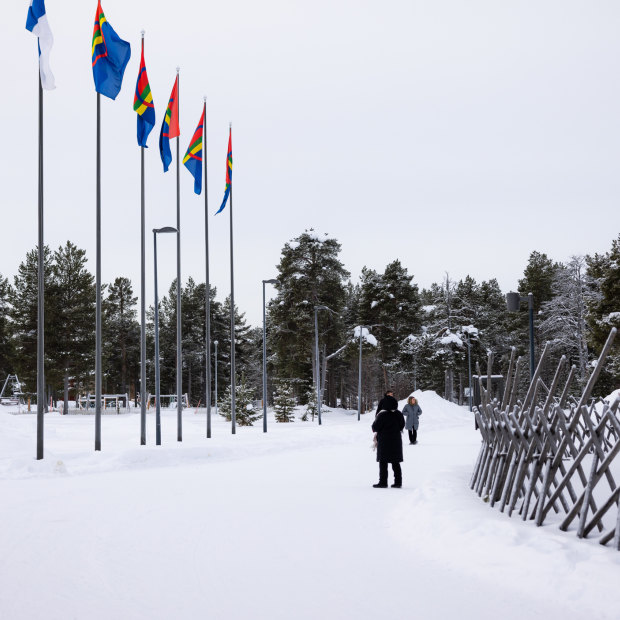
Inari in northern Finland is the home of the Sami parliament.
Inari, Finland: There aren’t many arguments against Indigenous representation that Tuomas Aslak Juuso hasn’t heard over the years. Nowadays nothing much seems to take him by surprise.
A reindeer herder by trade, Juuso is a veteran of Sami politics, having been elected to the Samediggi, Finland’s Indigenous parliament, when he was just 22. He remains the youngest member to take a seat.
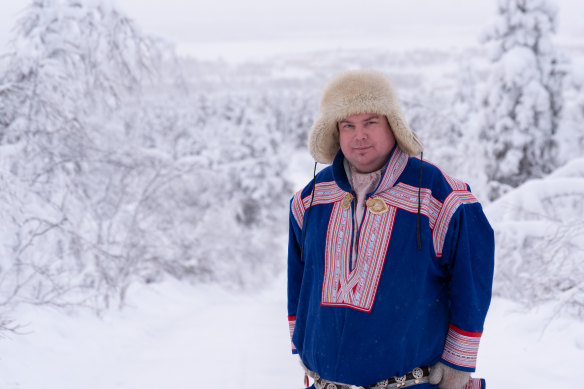
President of the Samediggi Tuomas Aslak Juuso.
Now 38 and having served several terms, he is the 25-member parliament’s president. It’s been a heavy burden over the past few years as the country’s Sami population pushes for further rights of autonomy and self-determination.
Juuso, through his long-time advocacy of Indigenous issues at the United Nations, has watched Australia’s Voice debate from afar and says there’s a sense of familiarity to it. His institution, too, has been criticised by its opponents for having too much power, and by his own community for not having enough, by those who think it shouldn’t exist as dividing the nation, vetoing industries and pitting communities against each other.
‘We show there is nothing to fear with giving Indigenous people a say on things that affect their lives.’
Tuomas Aslak Juuso, the president of Finland’s Indigenous parliament
“They are familiar arguments always,” he says from his home in Karesuvanto, the northernmost region in Finland, near its western border with Sweden. “Ultimately, I think we show there is nothing to fear with giving Indigenous people a say on things that affect their lives. I think we are a good example of how language and culture have survived by doing so.”
The Sami, who are the only recognised Indigenous people of Europe, number between 80,000 and 100,000 across the northernmost Arctic reaches of Finland, Norway, Sweden and Russia.
They were largely ignored by the Scandinavians who settled in the south but from the 17th century to the 1960s, as the economic potential of their homeland was realised, they were subjected to a systematic campaign of forced assimilation designed to eradicate their languages, culture and ancient shamanistic religion.
After Finland secured its independence from Russia, many of these policies continued. Even after World War II, a generation of Sami in Finland were compelled to leave their homes and go to boarding schools so they could be assimilated and raised as Finns.
Handicrafts, music and story-telling traditions all died out in many families, while large numbers were obliged to take Finnish-language names.
Almost every Sami family has stories to retell of the children taken away and beaten if they spoke Sami. Many had relatives from the same generation stripped naked and measured by officials trying to establish their racial inferiority. These experiences are now part of a truth and reconciliation commission.
Some Sami now reside in large cities, living side by side with Finns, far away from the northernmost lands of Europe where fishing, hunting and reindeer kept their ancestors alive for thousands of years.
Although the Sami live in a modern way in mixed communities, they still have strong kinship ties and an awareness of their own culture, which is distinct from the mainstream culture. And many, like Juuso, still fight to ensure that their ancient culture and traditions can coexist with the modern world.
“We have today an increasing generation of Sami people who were born in the city,” he says. “We are starting to discover the new challenges this poses on preserving and building up the Sami identity and the realisation of our rights.”
He says it would be wrong to say there are no divisions within the Sami community, which can often complicate the parliament’s capacity to articulate a clear position to the government. But he said the community unites on far more things than it is divided on.
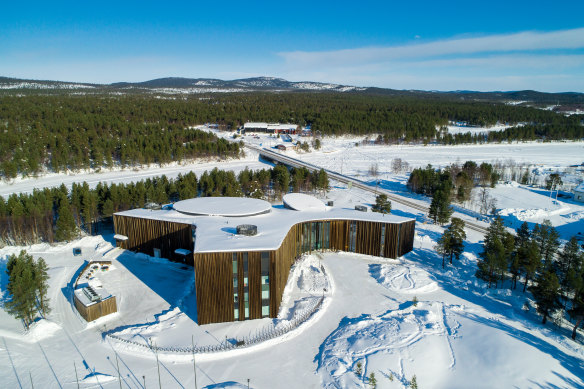
The Samediggi, Finland’s Indigenous parliament, which sits for around six weeks a year.
Juuso says part of the success of winning the right to be heard and consulted by the Finnish government has been the gains in schools with native language, many of which were at risk of dying out just a few decades ago.
“The constitutional right to preserve and develop the Sami culture and languages was very important, even when located outside the Sami homeland,” he says. “Using and learning our indigenous language in kindergartens, other social and educational services are very important for our identity.”
There are around 10,000 Sami in Finland, a country of 5.5 million, with a third of those still living in the traditional Sami homeland areas, called Sapmi, in Finnish Lapland. Since 1996, they have been represented by the Samediggi, a constitutionally recognised consultative body.
Not a parliament in a traditional Westminster sense, the body is a mainly consultative body whose purpose is to promote and preserve cultural self-determination, covering matters such as language, traditional livelihood, land rights and social wellbeing.
‘I know the new government is more supportive of the concept, but it obviously needs a vote. Which is hard, I’m told.’
Tuomas Aslak Juuso
Parliament, which sits for around six weeks a year in a purpose-built building in Inari, was established through legislation. It is elected every four years by about 6000 registered voters on the Sami electoral roll. Around half of those voted in the last election.
Under the law, the Finnish government, which does not have a minister for Indigenous affairs, is obliged to negotiate with the Sami on specific matters, including community planning, land and conservation management, applications for mining licences, the development, teaching and application of Sami languages, and legislative or administrative changes affecting Sami culture.
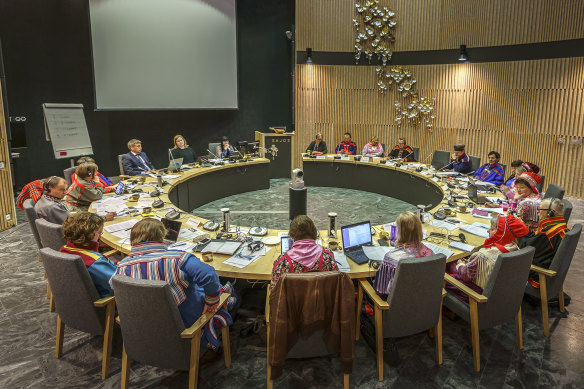
Inside the Samediggi, which was formed in 1996 to give a voice to the Sami.
However, the law does not preclude government authorities from proceeding with matters that have not been negotiated.
It has become a sore point among many and led to calls to beef up the parliament’s powers and triggered fierce debate over proposed changes.
Green colonialism
As Europe continues to transition towards green energy, experts say this pressure on the Sami is likely to increase. The vast open tundra of the north is attractive for wind power developments, proposed as part of Europe’s green energy future.
Likewise, massive rare earth mineral deposits located on Sami territory in northern Sweden, used for the production of electric batteries and motors, have been pitched as a key to Europe’s energy independence from China.
Sami politicians have been increasingly voicing their concerns against so-called green colonialism in their homeland. Along with neighbouring Norway and Sweden, Sami politicians claim that the climate action of governments has violated their rights to land, livelihoods and decision-making.
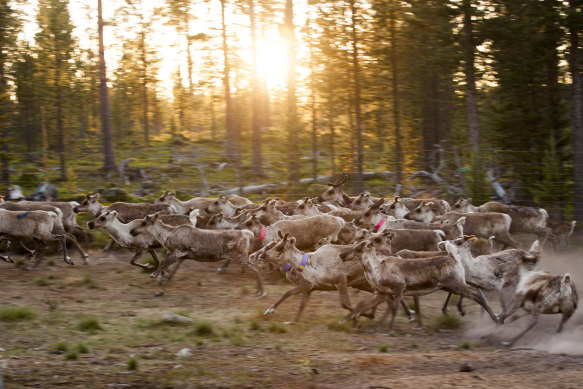
For thousands of years, the Sami lived in the northernmost lands of Europe where they survived off fishing, hunting and reindeer.
Most of the opposition relates to wind farms built and planned in the Sami territory, while mining projects for minerals needed for electric vehicle batteries have been given approval to explore. While they are part of efforts to end fossil fuel dependency, at the same time the projects can be seen as a continuum of centuries of repressive politics of the Nordic countries on Sami communities.
The authorities recently gave up on a hugely unpopular £3 billion ($5.9 billion) Arctic railway scheme that would have connected Lapland to the north coast of Norway, bisecting the reindeer herders’ pastures.
Without formal land rights in Finland, to prevent unwelcome developments, the Sami rely on demonstrating the impact on their cultural survival, which is protected by a clause in the Finnish constitution.
“Green colonialism is one of the challenges climate change brings, especially to our areas where a lot of resources are still untapped or unused,” Juuso says. “Especially wind parks or mining companies that come here in the name of the transition, wanting to utilise the resources that are on our grounds.”
Several mining companies have been awarded permits for exploration in the region over the past two years and there are plans for more than a dozen wind farms, which would displace the reindeer.
Though current legislation requires resource companies to consult Sami parliaments in a handful of countries on projects in their territory, experts say, in Finland at least, this has so far been largely a formality.
“The current criteria can be fulfilled by asking the Sami Parliament to write a letter,” Áslat Holmberg, who is president of the Sami Council, a transnational organisation that advocates on behalf of Sami in Finland, Sweden and Norway, says.
“Of course, they can withhold their consent, but it doesn’t have much of an impact.”
A model for Australia?
Juuso says there have been many inquiries from Australia since the Voice to parliament idea began to gather momentum following the Uluru Statement from the Heart. He finds it odd that there needs to be a referendum to establish the body but concedes he is no expert when it comes to the machinations.
“I know the new government is more supportive of the concept, but it obviously needs a vote. Which is hard, I’m told,” he says.
Dr Matt Harvey, a senior lecturer in law at Victoria University, has followed the Indigenous politics of the Nordic countries since he completed his studies in the European Union. He said the Sami Parliaments of the region had proved they could provide an important voice to an otherwise extreme minority.
“I think, in terms of the Voices in Australia, there is a lot to learn from the model,” he says.
“You want to know what the Sami people think about something, that is the place you go to. I must say the visible presence counts for something as well, showcasing Sami culture as well as being a voice for the people … and the educational function is a real practical function that it carries out as well as those other ones.
“I think all of those things have something to offer.”
Fighting for more rights
The idea of a Sami parliament still doesn’t sit right with all Finns. While Juuso says the community is broadly supportive of what powers they have been given, there remains vast online hate towards the nation’s Indigenous population and even some politicians.
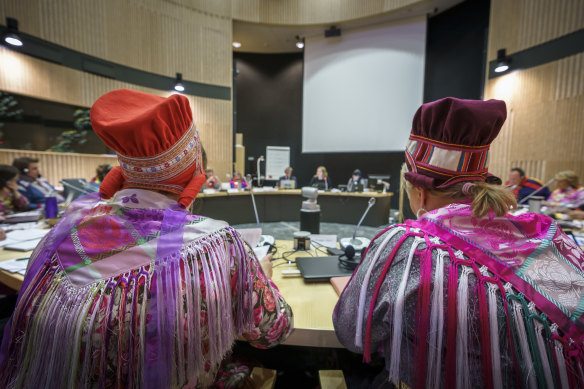
The Samediggi, Finland’s 25-member Indigenous parliament, meets for about six weeks a year.
Just a few years ago, a Finnish MP representing the Centre Party – then a part of the governing coalition – demanded openly that the Sami Parliament be closed down, and all funding cut off, claiming its electoral committee was guilty of legal offences and violations of human rights.
In addition to complaining to the state’s ombudsman, he announced that he had initiated a police investigation into the activities of the Electoral Committee. His Facebook pages were littered with comments labelling the Sami as “total pigs”, demanding an end to “the whole Sami Parliament shit”, and arguing that “the whole bunch” should be “placed in front of the wall”, seen as a reference to the style of execution used against leftist opposition during Finland’s 1918 Civil War.
“One of the most serious threats against Indigenous identities is hate speech, racism and other forms of discrimination,” Juuso says. “Especially, the Sami youth in the Nordic countries are increasingly harassed mentally, but also increasingly much in physical ways.”
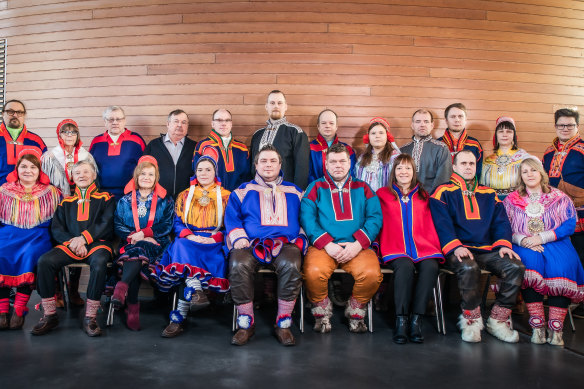
The elected members of the Sami parliament.
Last year, the Sami was filled with hope at the prospect of obtaining greater decision-making power over the natural resources of the north of the country – a policy that was promoted by the government led by then Social Democrat prime minister Sanna Marin. But that illusion vanished after her coalition fell apart on the issue and a new government, taking in conservatives and far-right MPs, triumphed in the parliamentary elections.
The hint of any Indigenous veto over development in Finland’s north has also raised strong objections from many in the Finnish community.
The northern councils of Enontekio and Sodankyla, which are both mining centres, were vocal opponents of the bill on the grounds it would overrule municipal decision-making.
Even in Inari, which is home to more than 2000 Sami, the local government described the bill as discriminatory and raised the threat of open violence.
“It is only a matter of time before the pressure between different population groups becomes too high and something irreversible happens,” they wrote in an open letter.

Former Finnish prime minister Sanna Marin was in favour of expanding the rights of the Indigenous parliament.Credit: Bloomberg
Part of the legislation put forward to overhaul the way the parliament works also attempted to resolve a decades-long debate over who gets a say in those negotiations in the first place.
In order for someone to be able to vote or be a candidate in the Sami elections, they must meet only one of three requirements: two are based on proof of a single ancestor’s ability in the Sami language, while one is related to the fulfilment of tax payments on fishing and hunting claims, which can go back several centuries. This verification system has been contentious due to how broad it is, clouding the very definition of Sami identity.
“Taxation records do not indicate ethnicity. It is a mark of livelihood,” said Juuso. “And this kind of livelihood practising does not build an automatic legitimacy to an ethnicity.”
Leo Aikio, one of two vice presidents of Samediggi, has been a long-time advocate of the change in what he sees as the flaws in the electoral roll, which have enabled the courts to allow more ethnic Finns to register as Sami. Those decisions drew condemnation from the United Nations, who called them a violation of Sami rights to self-determination.
He claimed if the law isn’t modified, there will come a time when the Finns take control of the chamber.
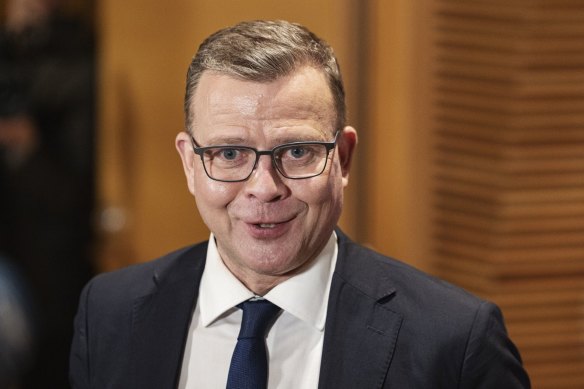
Current Finnish Prime Minister Petteri Orpo.Credit: Bloomberg
But several groups claiming to be representative of southern Samis, the Metsa or Forest Sami, call any efforts to remove the so-called Laplander criteria attempts at “ethnic cleansing” by northern Sami.
But Holmberg says relaxing the laws to allow more people to register would severely damage the Sami’s still fragile cultural self-governance
“It is about an existential threat to the legitimacy of the Sami Parliament,” he says. “The Sami representative body would lose its meaning if the decision-making power was exercised by others than the Sami.”
Prime Minister Petteri Orpo’s government is the fourth coalition to be dealing with reforms to rules related to the self-governance of the Sami.
A government spokesman said it hopes to consider reforms to the act by the end of this year, while Justice Minister Leena Meri, who has carriage of the legislation, has given assurances that her Finns Party, another right-wing populist party, is committed to the government program.
It has been a long journey and Juuso says he has patience.
“I really just hope that all MPs and the entire Finnish society will support the Sami Parliament and respect our right to decide on our own issues,” Juuso says.
Get a note directly from our foreign correspondents on what’s making headlines around the world. Sign up for the weekly What in the World newsletter here.
correction
A previous version of this article misstated the Sami population as between 80,000 and “1000,000”. The population is between 80,000 and 100,000.